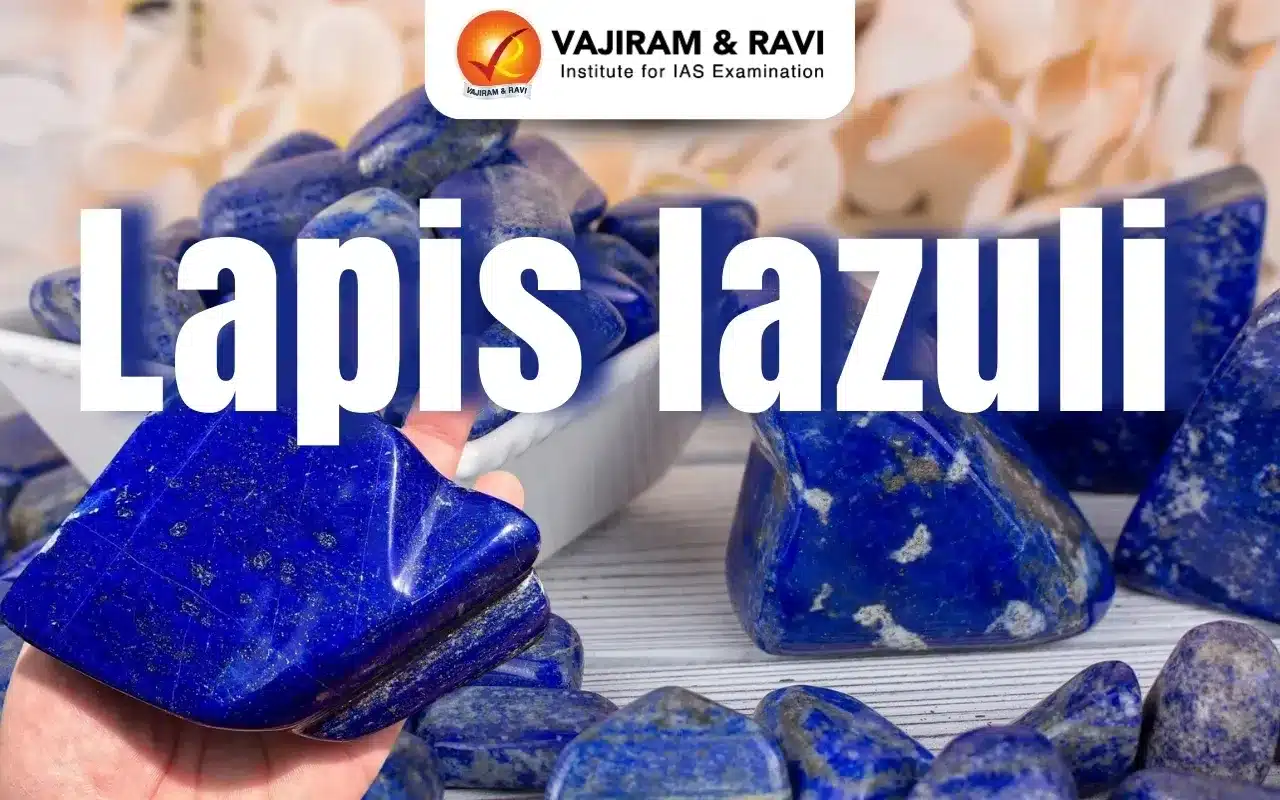Lapis Lazuli Latest News
Lapis Lazuli: The Earth’s Best Blue
What is Lapis Lazuli?
- Lapis lazuli is a vivid blue metamorphic rock, known for its striking colour and semi-precious gemstone value.
- It has been highly valued for thousands of years for use in jewellery, ornaments, and pigments.
- Etymology:
- “Lapis” (Latin) means stone.
- “Lazuli” (Persian – Lazward) means blue.
Composition of Lapis Lazuli
- The blue colour comes from lazurite (25-40%), a rare mineral.
- The shade of blue depends on the amount and structure of sulphur in lazurite.
- Other minerals present:
- Pyrite (gives golden streaks and sparkle).
- Calcite (reduces the blueness).
- Diopside and Sodalite (found in smaller quantities).
Where is Lapis Lazuli Found?
- Major sources include Afghanistan, Chile, Russia, and the United States.
- The highest-quality lapis lazuli is mined in Badakhshan province, Afghanistan, where it has been extracted for over 6,000 years.
Lapis Lazuli in History
- Ancient Trade and Use in India: Imported to India from Badakhshan as early as 1000 BCE.
- Ornaments made of lapis lazuli have been discovered at Indus Valley Civilization sites (Mohenjo-daro & Harappa).
- Ancient Egypt: Used in jewellery and ground into powder for eye shadow.
- Renaissance Europe: Ground into ultramarine, a rare and expensive blue pigment used by painters.
Lapis Lazuli FAQs
Q1: What is the Lapis Lazuli Corridor?
Ans: The Lapis Lazuli Corridor is an international transit route inaugurated in 2018, connecting Afghanistan to Turkey via Turkmenistan, Azerbaijan, and Georgia. This corridor facilitates trade and transportation between South Asia and Europe, enhancing regional economic integration.
Q2: Why is it called the “Lapis Lazuli” Corridor?
Ans: The name “Lapis Lazuli” is derived from the historic trade route through which lapis lazuli and other semi-precious stones were exported from Afghanistan over the past 2,000 years to regions like the Caucasus, Russia, the Balkans, and North Africa via the Silk Road.
Q3: Which countries does the Lapis Lazuli Corridor traverse?
Ans: The corridor begins in Afghanistan and passes through Turkmenistan, Azerbaijan, and Georgia, before reaching Turkey
Source: TH
Last updated on November, 2025
→ Check out the latest UPSC Syllabus 2026 here.
→ Join Vajiram & Ravi’s Interview Guidance Programme for expert help to crack your final UPSC stage.
→ UPSC Mains Result 2025 is now out.
→ UPSC Notification 2026 is scheduled to be released on January 14, 2026.
→ UPSC Calendar 2026 is released on 15th May, 2025.
→ The UPSC Vacancy 2025 were released 1129, out of which 979 were for UPSC CSE and remaining 150 are for UPSC IFoS.
→ UPSC Prelims 2026 will be conducted on 24th May, 2026 & UPSC Mains 2026 will be conducted on 21st August 2026.
→ The UPSC Selection Process is of 3 stages-Prelims, Mains and Interview.
→ UPSC Result 2024 is released with latest UPSC Marksheet 2024. Check Now!
→ UPSC Prelims Result 2025 is out now for the CSE held on 25 May 2025.
→ UPSC Toppers List 2024 is released now. Shakti Dubey is UPSC AIR 1 2024 Topper.
→ UPSC Prelims Question Paper 2025 and Unofficial Prelims Answer Key 2025 are available now.
→ UPSC Mains Question Paper 2025 is out for Essay, GS 1, 2, 3 & GS 4.
→ UPSC Mains Indian Language Question Paper 2025 is now out.
→ UPSC Mains Optional Question Paper 2025 is now out.
→ Also check Best IAS Coaching in Delhi

















